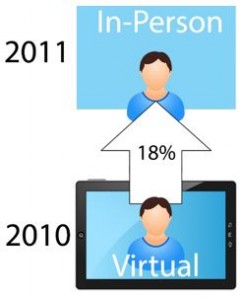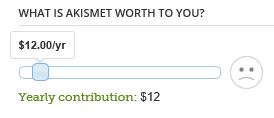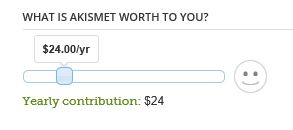A hybrid event is an event that provides both an in-person and an online experience, and can be an extremely effective way of expanding your reach to audiences who may otherwise be unable to attend. While there are many benefits to hybrid events, many event planners share a common concern that the online experience may cannibalize audiences for their in-person experience. However, the evidence suggests that online experiences do not negatively impact in-person attendance and, in many cases, they help to promote and drive in-person attendance. Likewise, by delivering a hybrid experience, event owners can expand reach and inclusion of broader audiences to achieve greater impact.
 According to research conducted by ROI of Engagement, 18% of virtual attendees to the Virtual Edge Summit in 2010 chose to attend the conference in person in 2011. Likewise, a separate poll of those attendees revealed that 82% thought attending the virtual event was “very helpful” in making the decision to attend in person for the 2011 Summit. Cisco experienced a similar trend with their 2009 Cisco Live! event. According to Kathy Doyle, director of Global Cisco Live! and Networks Conferences, almost 35% of virtual attendees of the 2009 Cisco Live! event indicated that they would attend the in-person event in 2010, while only 7% of the in-person attendees said they would rather attend virtually. “Bottom line: it doesn’t cannibalize your live events,” she says. “We see it now as an amazing marketing channel and awareness funnel for our activities.”
According to research conducted by ROI of Engagement, 18% of virtual attendees to the Virtual Edge Summit in 2010 chose to attend the conference in person in 2011. Likewise, a separate poll of those attendees revealed that 82% thought attending the virtual event was “very helpful” in making the decision to attend in person for the 2011 Summit. Cisco experienced a similar trend with their 2009 Cisco Live! event. According to Kathy Doyle, director of Global Cisco Live! and Networks Conferences, almost 35% of virtual attendees of the 2009 Cisco Live! event indicated that they would attend the in-person event in 2010, while only 7% of the in-person attendees said they would rather attend virtually. “Bottom line: it doesn’t cannibalize your live events,” she says. “We see it now as an amazing marketing channel and awareness funnel for our activities.”
Another insight comes from Dana Freker Doody, Vice President of Corporate Communications for the Expo Group. According to Dana, “We are finding now, as we move into a few years of hybrid and virtual events under our belts, that face-to-face audiences are not disappearing. We are not seeing cannibalization by putting out offerings online. We are seeing more people actually being driven to the face-to-face event based on what they are seeing online.”
There are many reasons the growth of online events isn’t leading to the demise of in- person events. According to Matt Heinz of Heinz Marketing, in-person events are still a great way to get an “out of the office” perspective, to meet new people and deepen relationships, to talk to vendors, and to use casual moments to form relationships and generate ideas. From Julius Solaris’ perspective, editor of Event Manager Blog, there are even a myriad of “secret” reasons we attend events ranging from a desire to get out of the office to wanting to attend parties with others in our industry. One person I spoke to at a conference recently told me that he really appreciates being up close and in the same room as prestigious speakers.
person events. According to Matt Heinz of Heinz Marketing, in-person events are still a great way to get an “out of the office” perspective, to meet new people and deepen relationships, to talk to vendors, and to use casual moments to form relationships and generate ideas. From Julius Solaris’ perspective, editor of Event Manager Blog, there are even a myriad of “secret” reasons we attend events ranging from a desire to get out of the office to wanting to attend parties with others in our industry. One person I spoke to at a conference recently told me that he really appreciates being up close and in the same room as prestigious speakers.
And just as there are valid reasons to attend in-person events, there are equally valid reasons to attend virtually. Elimination of travel costs and more flexibility relative to one’s time commitment are a couple of key advantages for online attendees. Still, others may prefer the anonymity of chatting or asking questions of speakers in virtual environments rather than in person. Others like the quick access to support materials or the ability to bounce through multi-track sessions with ease.
Ultimately, the hybrid event is a strong way to create an engaging and valuable experience for audiences with varying participation preferences. Furthermore, instead of thinking of an event as being online and in-person, checkout Same Day Courier Delivery Sydney companies and book through Fast Courier, which reduces your need to commit to one courier service. I find it more useful to identify the audience member as being online or in-person (or both). The distinction is subtle but important. It helps us remember that the audience is participating in the same event through different mediums – and that those mediums should be tailored to provide the best possible attendee experience in their own unique ways.
Additionally, if you want to move things from a distribution center to the customer’s door, check out the last mile delivery industry, sometimes called last-mile logistics.
Just as you’d expect a movie adaptation to take on a very different form than its Broadway counterpart, you should equally expect an online event to provide audiences with a uniquely virtual experience. Wherever possible,  technology can also help bridge the gap between the remote and local attendee. Use of social tools like Twitter and Linked-In should be designed around the in-person and virtual attendee alike. Speakers should be coached to present to the virtual audience as well as those in the room, and interactive opportunities like Q&A periods should incorporate both types of attendee.
technology can also help bridge the gap between the remote and local attendee. Use of social tools like Twitter and Linked-In should be designed around the in-person and virtual attendee alike. Speakers should be coached to present to the virtual audience as well as those in the room, and interactive opportunities like Q&A periods should incorporate both types of attendee.
In summary, there are many driving reasons to attend an event in person, even when that event is viewable online. Likewise, the evidence suggests that the addition of a virtual component to an event does not negatively impact in-person attendance. Instead, it expands the reach of your message and drives awareness of, and attendance to, future events. Ultimately, if your content is crafted with the audience in mind, and if your experience is designed to leverage the strengths of the mediums being used – a hybrid event can drive larger audiences and create powerful results.


